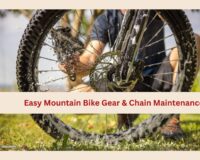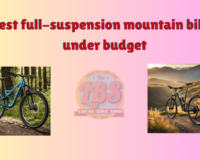Mountain Bike Tune Up Checklist! Are you ready to take your mountain biking experience to new heights? The key to unlocking peak performance lies in a well-maintained and finely-tuned mountain bike. Whether you’re a beginner or a seasoned rider, our ultimate tune-up checklist is here to guide you through essential maintenance tasks and advanced tuning techniques. Get ready to elevate your ride and ensure that your mountain bike is in top condition for your next thrilling adventure.
Pre-Ride Inspection:
Before hitting the trails, start with a thorough pre-ride inspection. Check for any visible damage, loose bolts, or worn-out components. Inspect your tires, brakes, and suspension system. Addressing issues at this stage can prevent more significant problems down the line.
Clean and Lubricate:
A clean bike is a happy bike. Regularly clean your mountain bike to remove dirt, mud, and debris that can affect performance. After cleaning, make sure to lubricate the chain, derailleurs, and other moving parts. This not only improves efficiency but also extends the lifespan of your components.
Brake System Check:
Your safety depends on the effectiveness of your brakes. Inspect brake pads for wear and replace them if needed. Check brake fluid levels in hydraulic systems and ensure proper brake lever responsiveness. A well-functioning brake system is crucial for navigating challenging terrains with confidence.
Gear Shifting and Drivetrain:
Smooth gear shifting is essential for conquering various terrains. Inspect the drivetrain for any signs of wear, and adjust the gears accordingly. Lubricate the chain and ensure that the derailleurs are properly aligned. A well-tuned drivetrain enhances your bike’s overall performance.
Suspension Setup:
Fine-tune your suspension settings based on your riding style, weight, and the type of terrain you’ll be tackling. Adjust the sag, rebound, and compression to optimize comfort and control. If you’re unsure about the settings, consider consulting your bike’s manual or seeking professional advice.
Wheel Inspection and Truing:
Inspect your wheels for any loose spokes, dents, or damage. Check for proper tire inflation and ensure that your wheels spin true. Wheel truing may be necessary to correct any wobbles, contributing to a smoother and more efficient ride.
Check Bearing Systems:
Bearings play a crucial role in the smooth operation of various bike components. Check and grease headset, bottom bracket, and hub bearings. Replacing worn-out bearings prevents unnecessary friction, ensuring a smoother ride and prolonging the life of your bike.
Frame and Component Torque Check:
Ensure that all bolts and fasteners on your bike are tightened to the manufacturer’s specifications. A torque wrench can be handy for this task. Pay special attention to critical areas such as the handlebars, stem, seatpost, and pedals. Proper torque prevents unnecessary stress on components and ensures your safety during rides.
Raise your mountain biking experience by incorporating our ultimate tune-up checklist into your regular maintenance routine. Whether you’re a beginner or an experienced rider, taking the time to address these key areas will ensure that your mountain bike delivers peak performance on every trail. Don’t just ride—conquer the mountains with confidence, knowing that your bike is finely-tuned and ready for any adventure that comes your way. Happy trails!
Introduction to Mountain Bike Tune-Up
Embarking on a mountain biking journey is not just about conquering challenging terrains; it’s a holistic experience that involves the rider and their trusty steed working seamlessly in tandem. Introducing the concept of a mountain bike tune-up is akin to investing in the longevity, performance, and safety of your two-wheeled companion. In this section, we delve into the importance of regular maintenance and explore the myriad benefits that a well-tuned bike can offer to riders of all skill levels.
Importance of Regular Maintenance
Imagine tackling steep descents, navigating rocky trails, or powering through muddy terrains with a bike that hasn’t received the attention it deserves. Regular maintenance is the foundation of a reliable and high-performance mountain bike. Beyond preventing breakdowns and ride interruptions, consistent care ensures that your bike operates at its full potential, enhancing your overall riding experience.
Preventing Costly Repairs
Neglecting maintenance can lead to minor issues snowballing into major repairs. Regular checks and tune-ups allow you to catch and address problems early, preventing them from evolving into costly fixes. A stitch in time indeed saves nine, and the same principle applies to bike maintenance.
Ensuring Safety on the Trails
Mountain biking is an exhilarating sport, but it comes with inherent risks, especially when tackling challenging terrains. Regular maintenance ensures that your brakes, gears, and other critical components are in top condition, contributing to a safer riding experience. A well-maintained bike responds predictably, allowing you to navigate obstacles with confidence.
Maximizing Performance
A finely-tuned mountain bike performs at its best. From smooth gear shifts to responsive brakes and efficient suspension, each component plays a role in elevating your riding experience. Regular maintenance optimizes these elements, ensuring that your bike is ready to tackle any trail you choose.
Benefits of a Well-Tuned Bike
Investing time and effort into tuning up your mountain bike pays dividends in terms of performance, durability, and overall enjoyment. Let’s explore the tangible benefits that riders can experience when their bikes are finely-tuned.
Enhanced Efficiency
A well-maintained drivetrain, properly inflated tires, and smooth gear shifts contribute to a more efficient ride. Every pedal stroke translates into forward momentum, allowing you to cover more ground with less effort. Efficiency is key, especially when conquering long climbs or challenging terrains.
Improved Handling and Control
Precision matters when navigating technical trails. A well-tuned suspension system, balanced wheel alignment, and responsive brakes enhance your bike’s handling and control. This translates to better maneuverability, allowing you to confidently tackle descents, corners, and obstacles.
Extended Lifespan of Components
Regular maintenance and tune-ups contribute to the longevity of your bike’s components. By addressing wear and tear promptly, you reduce the risk of premature failure and extend the lifespan of crucial parts. This not only saves you money on replacements but also ensures that your bike remains a reliable companion for years to come.
Personalized Riding Experience
Each rider has a unique style and preference when it comes to tackling trails. Fine-tuning your bike allows you to personalize its performance to match your riding style. Adjusting suspension settings, optimizing gear ratios, and fine-tuning other elements create a bespoke riding experience tailored to your preferences.
In the world of mountain biking, a well-tuned bike is not just a luxury; it’s a necessity. Regular maintenance is the key to unlocking the full potential of your mountain bike, ensuring that it performs at its best on every trail. As we journey through the subsequent sections of our ultimate tune-up checklist, keep in mind the invaluable benefits that await those who invest time and effort into the care of their trusty steed. Happy trails and happy riding!
Essential Tools for Mountain Bike Tune-Up
Taking on the journey of tuning up your mountain bike requires the right set of tools. Whether you’re a novice or a seasoned rider, having the basics on hand is essential for routine maintenance. Here’s a breakdown of the essential tools needed for a thorough mountain bike tune-up:
Multitool
A multitool is a compact, versatile tool that combines various functions into one handy device. It typically includes hex wrenches, screwdrivers, and a chain tool. This all-in-one tool is invaluable for making on-the-go adjustments and handling minor repairs during your rides.
Tire Levers
Changing a flat tire is a skill every mountain biker should master. Tire levers make this task much easier by helping you pry the tire away from the rim. Invest in a durable set of tire levers to streamline the process of fixing flats on the trail.
Pump
Keeping your tires properly inflated is crucial for a smooth and efficient ride. A reliable pump, whether a floor pump for home use or a compact hand pump for on-the-go adjustments, is an essential tool to maintain optimal tire pressure.
Chain Lubricant
Lubricating your chain is a fundamental aspect of bike maintenance. A good-quality chain lubricant keeps your drivetrain running smoothly, reduces friction, and extends the lifespan of your chain and cassette.
Cleaning Brushes
Dirt and grime can accumulate on your bike after every ride. A set of cleaning brushes, including a stiff brush for the drivetrain and softer brushes for other components, will help you keep your bike clean and ready for action.
Chain Checker
Monitoring the wear on your chain is crucial for preventing premature wear on other drivetrain components. A chain checker tool allows you to gauge chain wear accurately and determine when it’s time to replace your chain.
Torque Wrench
Precision is key when tightening bolts to manufacturer specifications. A torque wrench ensures that you apply the correct amount of force, preventing over-tightening or under-tightening, which can lead to component failure.
Advanced Tools for Advanced Tuning Techniques
If you’re ready to take your mountain bike tuning to the next level, consider adding these advanced tools to your kit. These tools are particularly useful for riders who want to delve into more intricate adjustments and optimizations:
Suspension Pump
Fine-tuning your suspension requires a suspension pump. This specialized pump allows you to adjust the air pressure in your fork and rear shock to achieve the optimal balance between comfort and performance.
Cassette Lockring Tool
When it’s time to replace your cassette or make adjustments to your rear hub, a cassette lockring tool is indispensable. This tool allows you to remove the lockring securing the cassette to the freehub body.
Bottom Bracket Tool
For servicing or replacing your bottom bracket, a bottom bracket tool is essential. Choose the tool that matches the specific type of bottom bracket on your bike, such as external or press-fit, to ensure a proper fit.
Wheel Truing Stand
Achieving perfectly true wheels contributes to a smoother ride. A wheel truing stand provides a stable platform for assessing and adjusting the true alignment of your wheels, ensuring they spin without wobbles.
Derailleur Hanger Alignment Gauge
A misaligned derailleur hanger can cause shifting issues. An alignment gauge allows you to check and correct the alignment of your derailleur hanger, ensuring precise gear changes.
Bearing Press and Puller
For more advanced maintenance tasks, such as replacing headset or bottom bracket bearings, a bearing press and puller set is invaluable. These tools help you remove and install bearings with precision.
As you progress in your mountain biking journey, acquiring and becoming proficient with these advanced tools will empower you to take on more intricate tuning techniques, ultimately enhancing the performance and longevity of your mountain bike. Remember, a well-maintained bike is a reliable bike, ready to tackle any trail with confidence. Happy tuning!
Pre-Ride Inspection Checklist
Your tires are the first point of contact with the trail, making them a critical element in your bike’s performance. Follow these steps to assess your tires:
Inflation: Use a reliable pump to check and adjust tire pressure according to the manufacturer’s recommendations. Optimal tire pressure provides the right balance between traction and efficiency.
Tread Condition: Inspect the tread for signs of wear, cuts, or punctures. Worn-out treads can compromise traction and increase the risk of flats. Replace tires that show significant wear.
Sidewall Inspection: Examine the sidewalls for any bulges, cuts, or damage. Damaged sidewalls may compromise the structural integrity of the tire and pose a safety risk.
Inspecting Brakes and Cables
A well-functioning brake system is paramount for your safety on the trails. Perform the following checks to ensure your brakes are in optimal condition:
Brake Pads: Inspect the brake pads for wear. Worn-out brake pads may reduce stopping power and increase braking distances. Replace pads that are excessively worn.
Brake Fluid (for Hydraulic Systems): Check the brake fluid level in hydraulic systems. Low fluid levels can affect brake performance. Top up the fluid if necessary, and inspect for any signs of leaks.
Cable Tension: For bikes with cable-actuated brakes, assess cable tension. Ensure there is no slack in the cables, and adjust as needed. Lubricate cables to ensure smooth operation.
Assessing the Drivetrain
A smooth and efficient drivetrain is essential for conquering various terrains. Follow these steps to assess and optimize your bike’s drivetrain:
Chain Lubrication: Apply a suitable chain lubricant to ensure a well-lubricated chain. Wipe off any excess lubricant to prevent attracting dirt and debris.
Gearing: Shift through all gears to ensure smooth and precise shifting. If you notice any hesitation or difficulty in shifting, make adjustments to the derailleur’s indexing.
Chain Wear: Use a chain checker tool to measure chain wear. If the chain is excessively worn, it can accelerate wear on other drivetrain components. Replace the chain if needed.
Crankset and Pedals: Check the crankset and pedals for tightness. Ensure that there is no play in the bottom bracket, and tighten any loose bolts.
By systematically going through this pre-ride inspection checklist, you set the foundation for a safe and enjoyable mountain biking experience. Regularly conducting these checks helps identify and address potential issues before they escalate, contributing to the overall reliability and performance of your mountain bike. Now that your bike has passed the pre-ride inspection, it’s time to hit the trails with confidence! Stay tuned for the next segments of our ultimate mountain bike tune-up guide as we delve into more advanced maintenance tasks and tuning techniques. Happy riding!
Cleaning and Lubrication: Elevating Your Mountain Bike’s Performance
Now that we’ve covered the essentials of the pre-ride inspection, let’s dive into the next crucial steps of mountain bike maintenance – cleaning and lubrication. These tasks may seem simple, but their impact on your bike’s performance and longevity is profound. Follow these guidelines to ensure your mountain bike stays in peak condition:
Proper Cleaning Techniques:
A clean bike not only looks great but also functions better. Dirt and grime can accelerate wear on components, hinder performance, and compromise the smooth operation of moving parts. Here’s a step-by-step guide to effective bike cleaning:
Gather Your Supplies: You’ll need a bucket of soapy water, a brush set (with soft and stiff brushes), a sponge, degreaser, and a hose for rinsing.
Remove Excess Dirt: Use a stiff brush to knock off loose dirt and mud from the frame, wheels, and components. Pay attention to hard-to-reach areas and the underside of the bike.
Soapy Water Wash: Mix a bike-friendly soap or mild detergent with water in the bucket. Use a sponge to wash the entire bike, including the frame, fork, wheels, and drivetrain. Avoid using high-pressure water directly on sensitive areas like bearings.
Degrease the Drivetrain: Apply a degreaser to the chain, cassette, and derailleur pulleys. Use a brush to scrub away built-up grease and grime. Rinse thoroughly.
Clean the Braking Surfaces: Wipe down the braking surfaces with a clean, damp cloth. Ensure that no contaminants, such as oil or grease, are present on the brake pads or rotors.
Inspect and Dry: While cleaning, inspect the frame and components for any signs of damage or wear. Once the bike is clean, use a dry cloth or towel to wipe away excess water.
You can best cleaning tools for your mountain bike at THE LOCAL BIKE SHOP starting from $11.99
Lubricating Key Components
Lubrication is the lifeblood of your bike. It reduces friction, prevents corrosion, and ensures smooth operation. Here’s how to properly lubricate key components:
Chain Lubrication: Apply a suitable chain lubricant to the chain, ensuring that each link is adequately coated. Wipe off excess lubricant with a clean cloth to prevent attracting dirt.
Derailleurs and Pivot Points: Use a light lubricant to coat the pivot points of derailleurs, brake levers, and other moving components. This reduces friction and enhances responsiveness.
Cables and Housing: Apply a small amount of lubricant to the exposed sections of cables. Work the lubricant into the housing by shifting through the gears and braking. This ensures smooth cable movement.
Pedal and Cleat Interface: Lubricate the pedal spindle and cleat interface to prevent creaking and ensure smooth engagement and disengagement.
Importance of Regular Cleaning and Lubrication
Regular cleaning and lubrication are not just cosmetic rituals – they are fundamental to the health and performance of your mountain bike. Here’s why these tasks should be integrated into your maintenance routine:
Prolongs Component Life: Dirt and grime act as abrasives, accelerating wear on critical components. Regular cleaning removes these contaminants, prolonging the lifespan of your bike’s parts.
Enhances Performance: A well-lubricated drivetrain and moving parts result in smoother operation. This, in turn, contributes to better shifting, braking, and overall bike performance.
Prevents Corrosion: Moisture and dirt can lead to corrosion, particularly on metal components. Lubrication creates a protective barrier, guarding against rust and corrosion and preserving the integrity of your bike.
Maintains Consistency: Consistency is key in mountain biking. Regular cleaning and lubrication ensure that your bike consistently performs at its best, allowing you to predict its behavior on the trail.
By incorporating proper cleaning techniques and timely lubrication into your mountain bike maintenance routine, you invest in the longevity and reliability of your trusted two-wheeled companion. Stay tuned for the next segment of our ultimate mountain bike tune-up guide, where we’ll explore the intricacies of the brake system and gearing. Happy trails and happy maintenance!
Adjusting and Tuning Components: Fine-Tuning Your Ride
Now that your mountain bike is clean and well-lubricated, it’s time to delve into the heart of the tuning process – adjusting and fine-tuning key components. Ensuring that your gears shift smoothly, your suspension is dialed in, and your brakes provide optimal performance is essential for an enjoyable and efficient ride. Let’s explore these adjustments in detail:
Fine-Tuning the Gears and Shifters
Smooth and precise gear shifts are crucial for conquering diverse terrains. Follow these steps to fine-tune your gears and shifters.
Check Derailleur Alignment: Ensure that the derailleur hanger is straight. Misalignment can lead to poor shifting performance. If necessary, use a derailleur hanger alignment tool to straighten it.
Adjust Cable Tension: Fine-tune the tension of your gear cables. Shift through all gears and make adjustments to the barrel adjusters as needed. A well-adjusted cable tension ensures crisp and reliable shifts.
Indexing Gears: If your gears are not shifting smoothly, indexing may be required. Use the barrel adjusters to align the jockey wheel with each gear. The goal is to achieve precise alignment for smooth shifting.
Limit Screw Adjustments: Ensure that the limit screws on the front and rear derailleurs are set correctly. These screws determine how far the chain can move, preventing over-shifting or dropping the chain.
Adjusting the Suspension
Fine-tuning your suspension settings enhances comfort, control, and performance on the trail. Here’s how to adjust your suspension:
Set Sag: Adjust the air pressure or preload on your suspension to achieve the recommended sag. This is the amount the suspension compresses under your weight when you’re on the bike. Refer to your bike’s manual for the appropriate sag settings.
Rebound Damping: Adjust the rebound damping to control how quickly your suspension returns after compressing. A slower rebound is ideal for technical descents, while a faster rebound suits smoother terrain.
Compression Damping: Some suspension systems offer adjustable compression damping. Experiment with these settings based on the type of terrain you’ll be riding. Increase compression for smoother trails and decrease for rougher terrains.
Aligning the Brakes for Optimal Performance
Brakes are your primary means of control, and ensuring they operate at their best is paramount. Here’s how to align and optimize your brakes:
Check Brake Pad Alignment: Ensure that the brake pads are evenly aligned with the braking surface on the rotor. Adjust the caliper position if necessary to achieve optimal alignment.
Inspect and Align Rotors: Examine the rotors for any warping or damage. If the rotors are bent, use a rotor truing tool to straighten them. Properly aligned rotors prevent brake squeal and improve braking performance.
Brake Lever Adjustment: Adjust the brake lever to your preference. A comfortable lever reach ensures that you can easily modulate braking force with your fingers.
Wrapping Up Your Tune-Up
With your gears, suspension, and brakes finely tuned, it’s time to wrap up your mountain bike tune-up with a final inspection and a test ride:
Final Inspection and Test Ride
Inspect Bolts and Fasteners: Double-check that all bolts and fasteners are tightened to the manufacturer’s specifications. Pay special attention to critical areas such as the handlebars, stem, seatpost, and pedals.
Check for Any Unusual Noises: Spin the wheels, bounce the suspension, and compress the brakes. Listen for any unusual noises that might indicate loose components or potential issues.
Test Shifting and Braking: Take your bike for a short test ride to ensure that the gears shift smoothly, the suspension performs as expected, and the brakes provide reliable stopping power. Address any issues that arise during the test ride.
Tips for Ongoing Maintenance
Maintaining your mountain bike’s performance is an ongoing process. Consider these tips for regular upkeep:
Clean and Lubricate Regularly: Schedule routine cleaning and lubrication sessions to keep your bike in top condition. This prevents the accumulation of dirt and ensures smooth operation.
Inspect and Replace Wearable Parts: Regularly inspect components such as brake pads, chain, cassette, and tires for signs of wear. Replace these parts promptly to prevent further damage and maintain optimal performance.
Keep an Eye on Suspension Settings: Adjust your suspension settings based on the type of terrain you’ll be riding. Experiment with different settings to find what works best for your riding style.
Benefits of a Well-Tuned Bike for Performance and Longevity
Maintaining a well-tuned mountain bike offers numerous benefits, including:
Optimal Performance: A well-tuned bike performs at its best, providing smooth shifting, responsive braking, and efficient power transfer.
Longer Component Lifespan: Regular maintenance prevents premature wear and extends the lifespan of crucial components such as chains, cassettes, and brake pads.
Consistent and Predictable Riding Experience: A bike that is consistently well-tuned allows you to predict its behavior on the trail, enhancing your confidence and control.
Reduced Risk of Breakdowns: Addressing potential issues during regular tune-ups reduces the risk of unexpected breakdowns on the trail, ensuring a safer riding experience.
Congratulations! You’ve completed the ultimate mountain bike tune-up. By following these steps and incorporating regular maintenance into your routine, you’re not only enhancing your bike’s performance but also prolonging its lifespan. Get ready to hit the trails with confidence, knowing that your mountain bike is finely tuned and ready for any adventure that comes your way. Happy riding!











